LEON JAMAER TECHNIQUE | THE ART OF ONSHORE
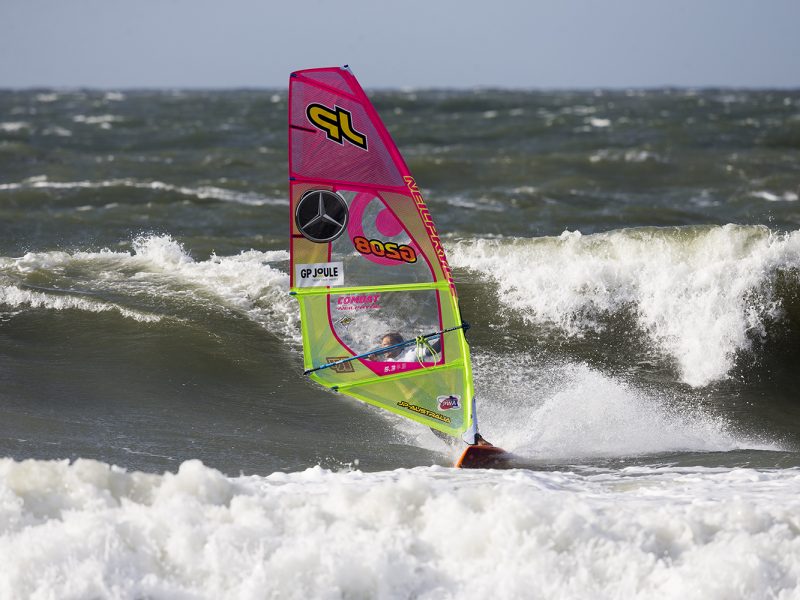
Leon Jamaer rips no matter what the conditions, from the extremes of the Red Bull Storm chase to winning German wave events on his home waters off the North Sea. Unlike a lot of his peers, Leon still spends a large amount of time training in Northern Europe and as such his onshore game is strong! We asked him to share some of his tips for the art of onshore wave sailing.
Words Leon Jamaer // Photos John Carter
Chaotically crumbling onshore waves, patchy wind and lots of current is not exactly the material that our wave riding dreams are made of. However, it represents the conditions that most European sailors deal with most of the time, especially in small stretches of water where groundswells can´t exist. Onshore or side-onshore wind is, after all, the best guarantee for at least some waves. Yet, onshore wind often goes hand in hand with a set of difficulties that the sailor will have to face. First of all, the wave patterns are very unorganized and chaotic. Waves break all over the spot, there are hardly any clearly distinguishable sets coming in and there is no defined impact zone. Because the wind literally pushes the waves towards the shore, the wave’s top breaks earlier than usual, which results in a rather mushy and gutless wave face. In onshore conditions the wind is normally patchier and lighter close to the shore than further out at sea. This is due to obstacles on land like buildings, trees or cliffs, which hinder the wind from passing through without resistance (in German we call this phenomenon Luvstau). Furthermore, all the water that is being pushed towards the shore has to go somewhere. The back stream often creates strong currents, which makes it even harder to get going. Nonetheless, not everything about onshore is bad. In fact, some manoeuvres become easier and lots of onshore practice can refine your sailing technique a lot. To successfully master all the challenges there are certain equipment choices, trims and techniques that will make your life a lot easier and will enable you to maximize your sailing potential and joy on the water.
RIGS
To be able to get on the plane your onshore sail should have a decent amount of power. At the same time, it should also be very easy to control and have lots of stability so you don´t get too overpowered when using a slightly bigger sail. In general it helps to choose a sail size which is a little bit bigger when the wind is gusty and full of patches. As onshore waves have hardly any push, all the acceleration and momentum has to be generated by the sail! Usually five batten sails have more stability than four batten sails, which have more stability than three batten sails. Especially the clew of a five batten sail is very stable, which is important when the bottom turn becomes more stretched out and you go clew first towards the lip. Trimming the sail with a tiny bit more down and outhaul can also help to increase the sails controllability without sacrificing much acceleration. Putting the boom a little bit higher than usual will help you to plane earlier as well as the board doesn´t get pressed down into the water so much.
“Lots of onshore practice can refine your sailing technique a lot.”
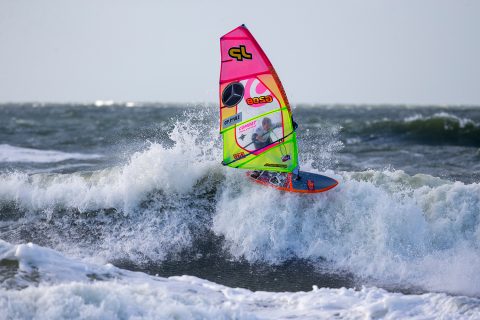
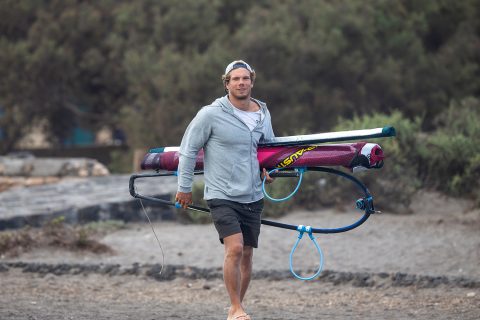
BOARDS
Whether to use a bigger board than usual or not can be a matter of taste. Most important is that your board can plane freely and easily. This can be due to a flat rocker line, a wide tail or bottom contours like for example a single concave, which creates extra lift. Bigger and stiffer fins positioned a tiny bit further back than usual will further help to keep speed on the wave. Most people say thrusters work better than quads in onshore conditions. However, in my opinion, quads can also be great onshore boards. I use the exact same quad board in pumping Ho’okipa and dead onshore Sylt. The only difference is that I put the rear fins about 5-8 mm further back when it’s onshore.


JUMPS
Jumping and wave riding techniques change quite a bit when the wind turns from side-shore to onshore. In side-shore conditions you head out at a right angle from the beach, which means the waves will come right at you and you don´t need to change your direction to use the wave as a ramp. In comparison, when it’s more onshore you are moving parallel to the swell, rather than actually crossing it. Therefore, in order to take off and use the wave as a kicker you need to carve into the wind. This necessity will make some jumps a lot harder than others. Back loops and tabletops for example work fine in onshore conditions, as you would take off and jump into the wind anyway. With back loops in onshore a popular problem is that you either over or under rotate. You will need to actively jump into the wind and initiate the rotation in order to not under rotate. Once you have passed the highest point however, you really need to slow the rotation down and control the landing. Therefore, it is very important to compress and stay close to the equipment. Don´t lose your body tension and faith! Forward loops and push loops can be a little tricky in onshore conditions. For push loops, you want a decent ramp that allows you to gain some height so your mast won´t get stuck in the water mid rotation; that is crucial in onshore conditions. For forward loops you don´t want to take off too much into the wind, as this will make the rotation a little strange and difficult. If you want to stall your forward though, you might have to take off after carving into the wind. Then while in the air, compress at the highest point and point the nose of the board away from the wind and towards the beach before you initiate the rotation. While in side-shore conditions you often get away with some technique flaws, in onshore conditions most of the time you will get punished for them straight away. So always remember the important basics of each trick. For forward loops, move the back hand further back, look back over your shoulder and compress.
“Always remember the important basics of each trick.”
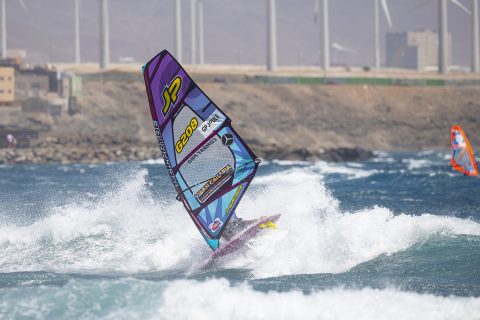
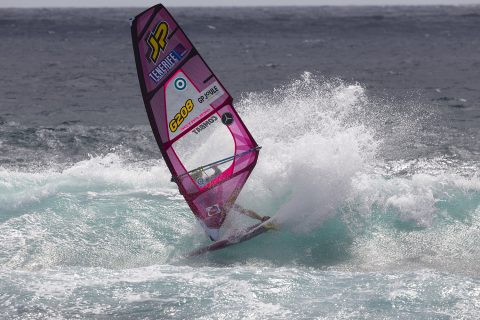
RIDING
Using the same logic, that you move parallel to the waves, also affects wave riding when wind and waves come out of the same direction. In side-shore conditions your bottom turn will do at least a 90 degree direction change before you initiate the cutback. In dead onshore conditions however, you will have to turn at least 180 degrees in order to hit the lip. To successfully manage this huge direction change with speed and flow it is important to have a board that planes well and a sail that stays stable and provides control. Normally, you won´t bottom turn super tight and lay the rig down, so your board doesn´t need to turn ultra radical. Although it helps if the bottom to top turn combo is one smooth transition and your board doesn´t go flat midway. By the time you approach the lip for the cutback you might have a lot of power, as most sails tend to load up when going clew first. Grab the boom wide to control all that energy. The cutback should be gentle and controlled. If you push too hard you will quickly lose traction and spin out. To prevent this from happening I put my rear fins further back, as mentioned before. The best technique tip for the side-onshore bottom turn that I can give is to compress low and lean forward. Jaeger Stone has this really dialled. Don´t think you have to lay the sail down. It is more important to have the sail upright so it constantly faces the wind. Once the wind is almost dead onshore it can help to shift the sail mid bottom turn. The shift might be tricky, but once you hit the lip you will have a lot more sail control. You can also go more vertical and really carve the board into the water. After the cutback you normally shift the sail back to the normal position. If you want to link many turns on an onshore wave you will often have the problem that the wave will roll away underneath your board. You might lose the wave because on this downwind course towards the beach your sail is not powered up anymore. To prevent this from happening I recommend a bigger sail and bigger fins.
Talking about wave manoeuvres, some can become easier when the wind is onshore, e.g. wave 360s, shakas or sliding takas. Other manoeuvres like goiters or air takas become harder though. Backside riding is a big deal in onshore. You can use a wave that suddenly stands up in front of you to hammer a big backside slash, throw a shove it or shaka or to implement other jumps into the ride. Onshore winds will often transform a spot into a huge playing field with lots of ramps. With the right equipment choice you can refine your sailing technique and learn new manoeuvres. It also gives a lot of room for improvisation and to implement tricks into wave riding, so stay open minded and be creative on the water! The starboard tack onshore conditions around Marseille are Thomas Traversa’s bread and butter. Look where that took him!
“Onshore winds will often transform a spot into a huge playing field.”
The post LEON JAMAER TECHNIQUE | THE ART OF ONSHORE appeared first on Windsurf Magazine.
Windsurf Magazine https://ift.tt/39hWBFy